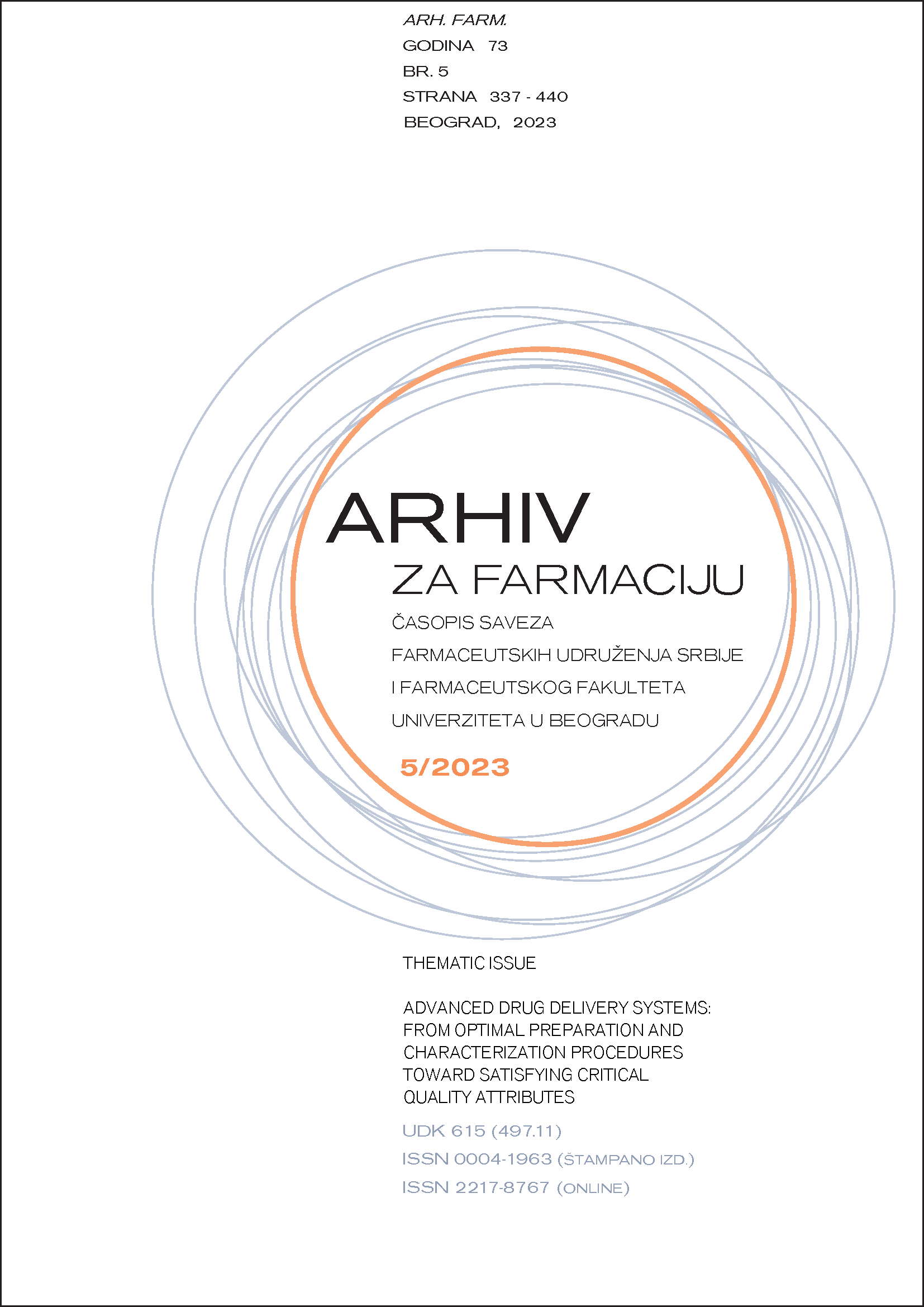Biocompatible lipid nanocarriers for improved skin delivery of fluocinolone acetonide: physicochemical and in vitro performances
Abstract
In order to improve the delivery of topical corticosteroids into inflammatory skin lesions while reducing the likelihood of adverse effects, lipid nanocarriers have received increasing attention. Hence, this study aimed to develop biocompatible nanoemulsions (NEs) and nanostructured lipid carriers (NLCs) as carriers for fluocinolone acetonide (FA) by carefully optimizing the formulation and process parameters. After an analysis of the relevant physicochemical parameters and stability testing, in vitro release and permeation tests were performed to evaluate whether the nanocarriers affected the penetration of FA into/through the skin compared to a conventional reference product (Sinoderm® cream). The developed NEs exhibited satisfactory physicochemical properties (droplet size <200 nm, PDI<0.2, ZP>ǀ-30ǀ mV, pH ~ 4.75) and long-term stability. Although the developed NLCs initially had satisfactory properties, gelation was observed within 3 months of storage, implying that further formulation testing is required to resolve the limited stability of these systems. In vitro release/permeation findings suggest that the developed nanocarriers (especially NEs) provide better delivery of FA into/though the skin compared to the Sinoderm® cream. Therefore, a lecithin-based NE with a 10% lipid phase (medium-chain triglycerides/oleic acid 3:1) is a promising strategy for improved delivery of FA to the inflamed skin, allowing for ease of application, especially to larger skin surfaces and hairy regions.
References
Barnetson RS, White AD. The use of corticosteroids in dermatological practice. Med J Aust. 1992;156(6):428-31.
Wang TS, Tsai TF. Managing scalp psoriasis: an evidence-based review. Am J Clin Dermatol. 2017;18(1):7-43.
Lipozenčić J, Gorgievska Sukarovska B. Topical Corticosteroids in Dermatovenerology – When, Why and What?. Medicus. 2007;16(1):95-9.
Pradhan M, Singh D, Singh MR. Development characterization and skin permeating potential of lipid based novel delivery system for topical treatment of psoriasis. Chem Phys Lipids. 2015;186:9-16.
Raza H, Shah SU, Ali Z, Khan AU, Rajput IB, Farid A, et al. In Vitro and Ex Vivo Evaluation of Fluocinolone Acetonide-Acitretin-Coloaded Nanostructured Lipid Carriers for Topical Treatment of Psoriasis. Gels. 2022;8(11):74.
Pradhan M, Yadav K, Singh D, Singh MR. Topical delivery of fluocinolone acetonide integrated NLCs and salicylic acid enriched gel: A potential and synergistic approach in the management of psoriasis. J Drug Deliv Sci Technol. 2021;61:10228.
Pradhan M, Alexander A, Singh MR, Singh D, Saraf S, Saraf, S. Understanding the prospective of nano-formulations towards the treatment of psoriasis. Biomed Pharmacother. 2018;107:447-63.
Alam M, Rizwanullah M, Mir SR, Amin S. Promising prospects of lipid-based topical nanocarriers for the treatment of psoriasis. OpenNano. 2023;10:100123.
Savić V, Ilić T, Nikolić I, Marković B, Čalija B, Cekić N, Savić S. Tacrolimus-loaded lecithin-based nanostructured lipid carrier and nanoemulsion with propylene glycol monocaprylate as a liquid lipid: Formulation characterization and assessment of dermal delivery compared to referent ointment. Int J Pharm. 2019;569:118624.
Sravanthi V, Pallavi MP, Bonam SR, Sathyabama S, Kumar HMS. Oleic acid nanoemulsion for nasal vaccination: Impact on adjuvanticity based immune response. J Drug Deliv Sci Technol. 2015;28:56-63.
Abd E, Benson HA, Roberts MS, Grice JE. Minoxidil skin delivery from nanoemulsion formulations containing eucalyptol or oleic acid: Enhanced diffusivity and follicular targeting. Pharmaceutics. 2018;10(1):19.
Ilić T, Pantelić I, Lunter D, Đorđević S, Marković B, Ranković D, et al. Critical quality attributes, in vitro release and correlated in vitro skin permeation-in vivo tape stripping collective data for demonstrating therapeutic (non)equivalence of topical semisolids: A case study of "ready-to-use" vehicles. Int J Pharm. 2017;528(1-2):253-67.
Katyan K, Sharma R, Sharma A. Preparation and characterization of a fluocinolone acetonide nanoemulsion as a topical delivery system. J Med Allied Sci. 2022. doi: 10.22270/jmpas.V11I1.2118
Teeranachaideekul V, Boonme P, Souto EB, Müller RH, Junyaprasert VB. Influence of oil content on physicochemical properties and skin distribution of Nile red-loaded NLC. J Control Release. 2008;128(2):134-41.
Klang V, Valenta C. Lecithin-based nanoemulsions. J Drug Del Sci Tech. 2011;21:55–76.
Isailović, T, Đorđević S, Marković B, Ranđelović D, Cekić N, Lukić M, Savić S. Biocompatible nanoemulsions for improved aceclofenac skin delivery: formulation approach using combined mixture-process experimental design. J Pharm Sci. 2016;105(1):308-23.
Jafari SM, Assadpoor E, He Y, Bhandari B. Re-coalescence of emulsion droplets during high-energy emulsification. Food Hydrocoll. 2008;22:1191-202.
Müller RH, Harden D, Keck CM. Development of industrially feasible concentrated 30% and 40% nanoemulsions for intravenous drug delivery. Drug Dev Ind Pharm. 2012;38:420-30.
Müller RH, Radtke M, Wissing SA. Solid lipid nanoparticles (SLN) and nanostructured lipid carriers (NLC) in cosmetic and dermatological preparations. Adv Drug Deliv Rev. 2002;54:131-55.
Teeranachaideekul V, Boribalnukul P, Morakul B, Junyaprasert VB. Influence of Vegetable Oils on In Vitro Performance of Lutein-Loaded Lipid Carriers for Skin Delivery: Nanostructured Lipid Carriers vs. Nanoemulsions. Pharmaceutics. 2022;14(10):2160.
Wolf M, Reiter F, Heuser T, Kotisch H, Klang V, Valenta C. Monoacylphospatidylcholine based drug delivery systems for lipophilic drugs: nanostructured lipid carriers vs. nano-sized emulsions. J Drug Deliv Sci Tech. 2018;46:490–7.
Montenegro L, Parenti C, Turnaturi R, Pasquinucci L. Resveratrol-loaded lipid nanocarriers: correlation between in vitro occlusion factor and in vivo skin hydrating effect. Pharmaceutics. 2017;9(4):58.
Baspinar Y, Keck CM, Borcher HH. Development of a positively charged prednicarbate nanoemulsion. Int J Pharm. 2010;383:201–8.
Bernardi DS, Pereira TA, Maciel NR, Bortoloto J, Viera GS, Oliveira GC, Rocha Filho PA. Formation and stability of oil-in-water nanoemulsions containing rice bran oil: in vitro and in vivo assessments. J Nanobiotechnol. 2011;9:44.

